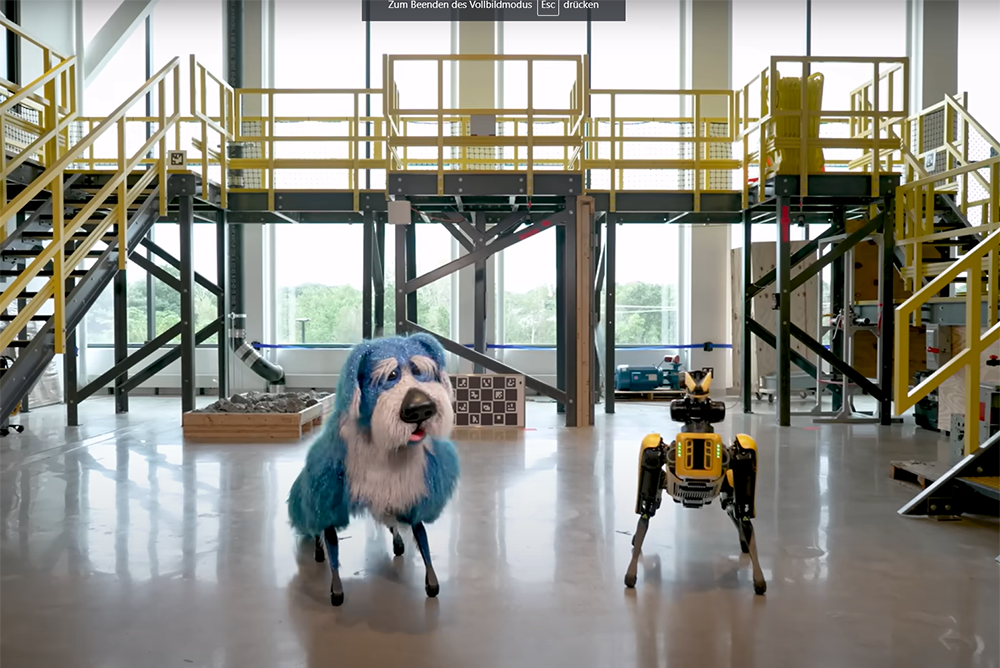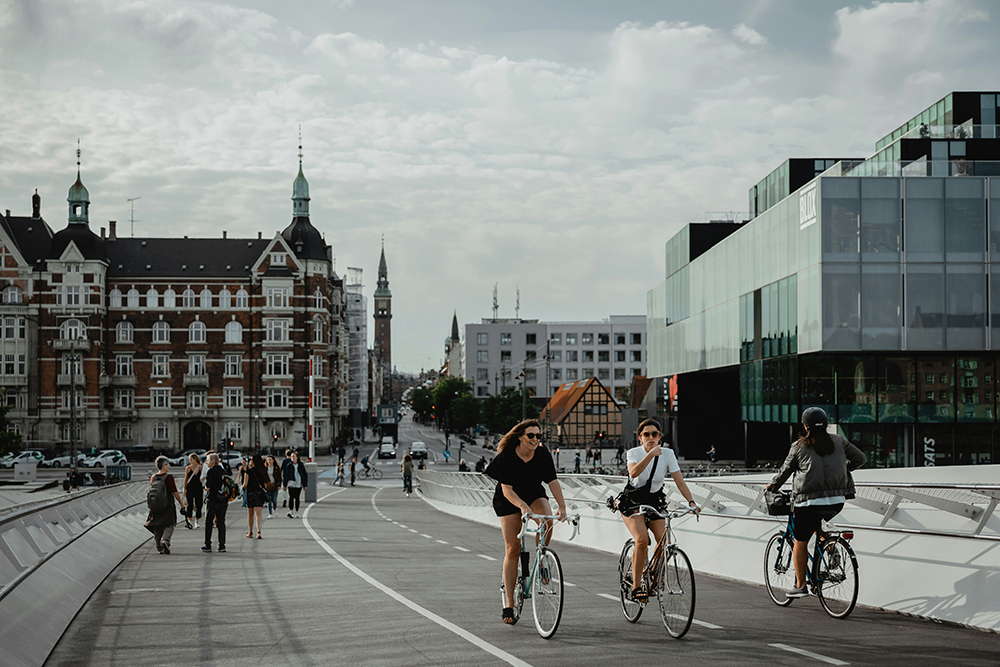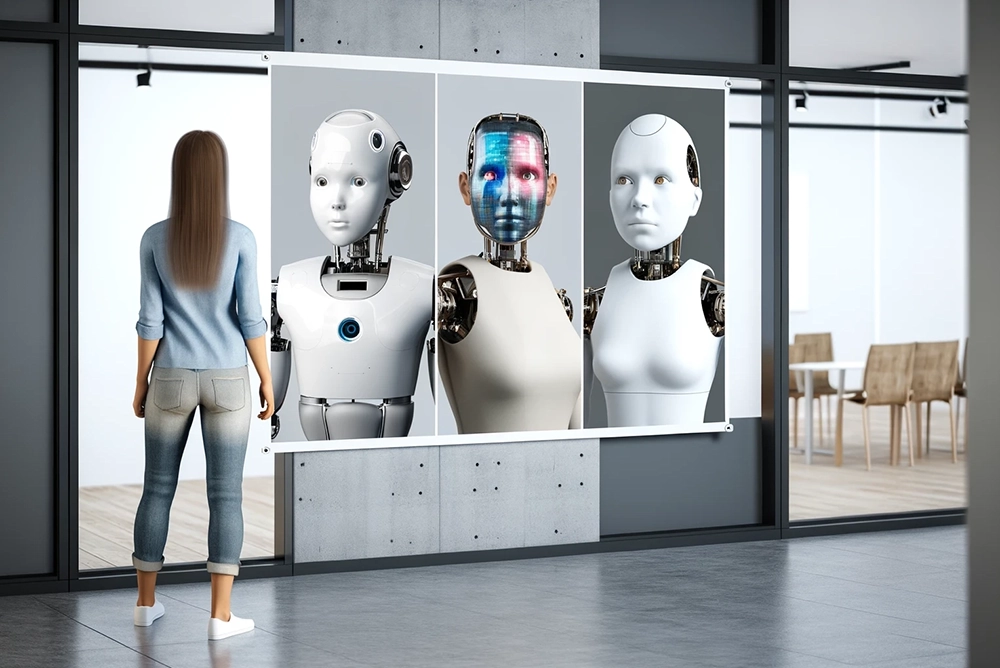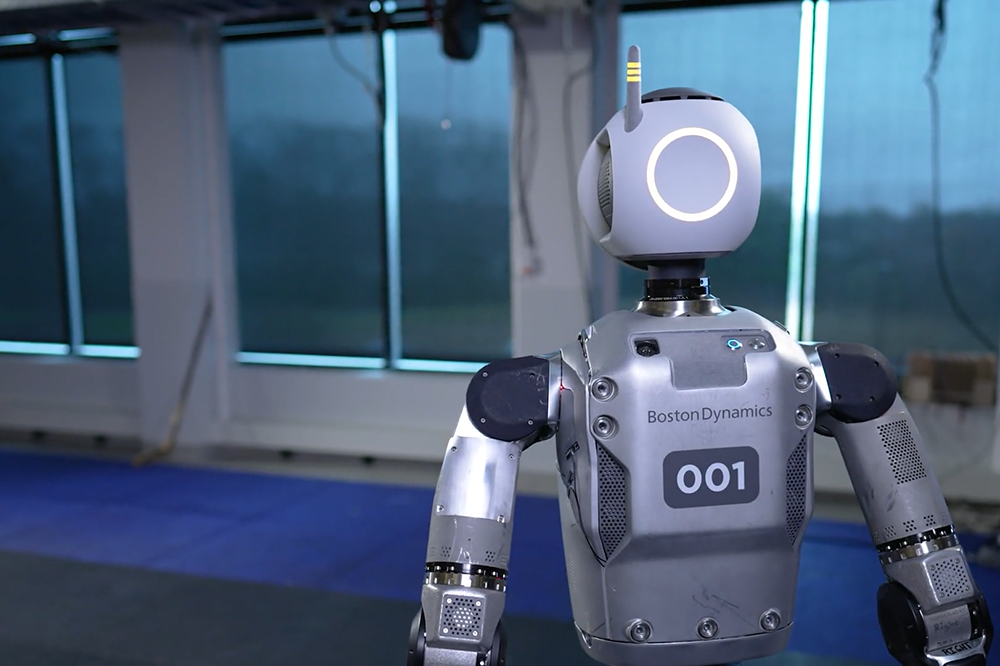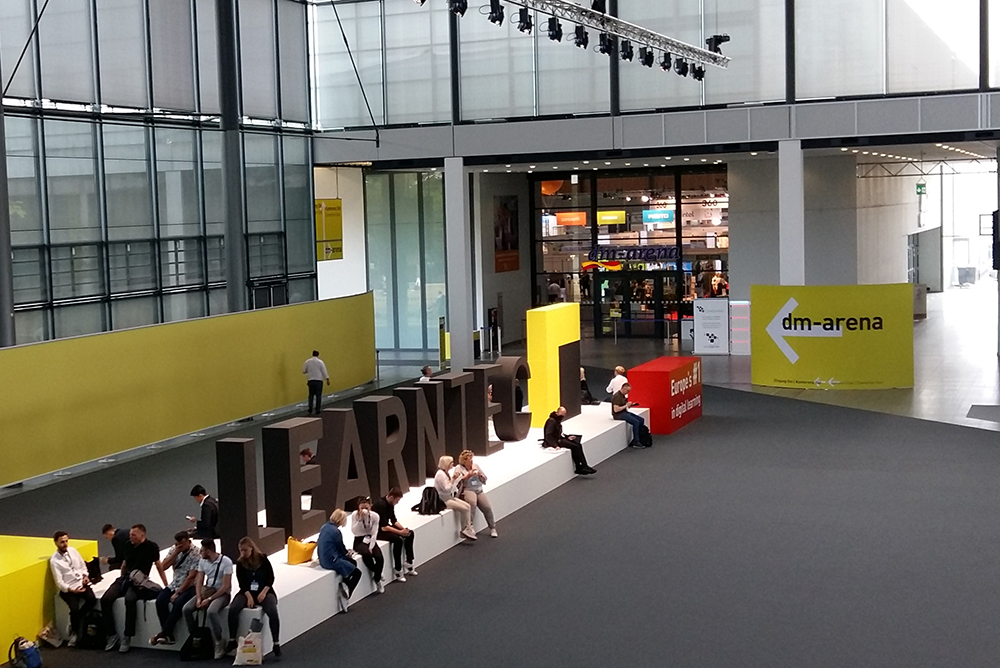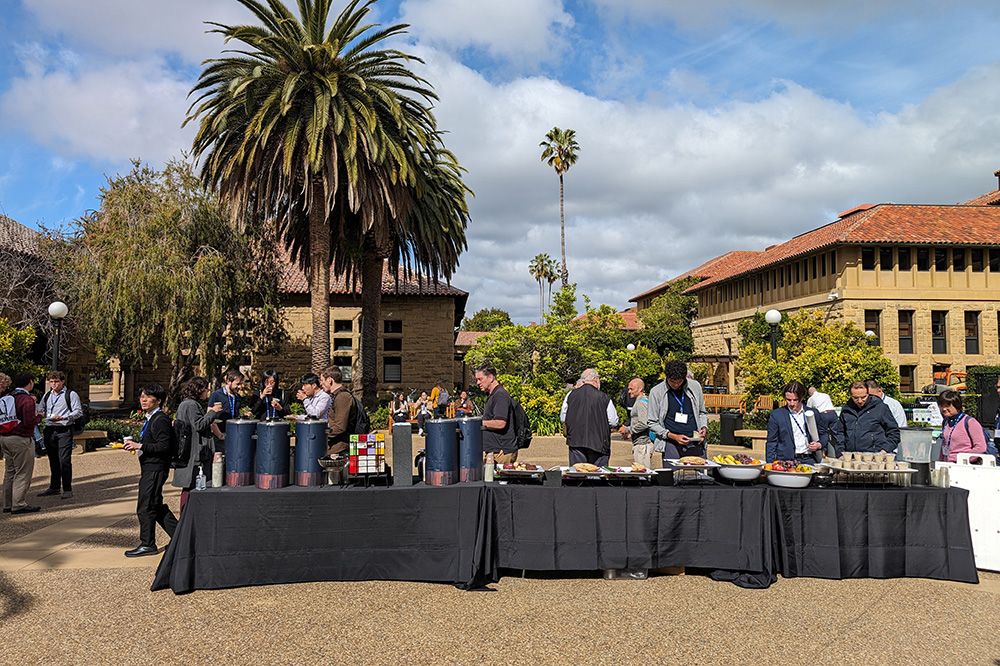Prof. Dr. Oliver Bendel introduced the term “robot enhancement” in 2020 and has since used it in several articles and book chapters. Robot enhancement is the extension and associated modification or improvement of the robot by the user or a company, for example in functional, aesthetic, ethical or economic terms. The word was coined in reference to “human enhancement” and “animal enhancement”, and can be used to describe both the field of work and the object. One form of robot enhancement is social robot enhancement, in which a social robot is enhanced or modified and improved. An impressive example of robot enhancement is shown in a video by Boston Dynamics. A “naked” spot and a spot with a dog costume dance together in the hall where Atlas used to be seen again and again. Such robot enhancement should not necessarily be imitated by the user. There are some robots that cannot stand the costume and will heat up – to the point of becoming defective (Photo: YouTube/Boston Dynamics).
ICSR 2024 + Competition
The main conference of the ICSR will be held in Odense in 2024, and its full name is “16th International Conference on Social Robotics +AI”. There is also the ICSR-2024 Competition in Naples, Italy. According to the website, it is “The 1st Competition of the International Conference on Social Robotics”. The new format will take place on 8-9 May 2024. The General Chair explains the intention of the event: “ICSR Competition aims at being not only a competition but an extraordinary showcase of innovation and talent in the field of robotics. This event marks the convergence of brilliance, where teams comprising students, PhD students, researchers, and esteemed professors will compete in a series of captivating competitions through a groundbreaking exploration into the realms of robotics, where cutting-edge technologies and social applications come together. In the spirit of fostering collaboration and pushing the boundaries of what is possible, our competitions will showcase the diverse capabilities of robotics.” (Website ICSR-24 Competition) According to the organizers, teams will compete in four different competitions: the Robotic Arm Challenge, the Humanoid Robot Challenge, the Robot Design Challenge, and the Game Jam Challenge. More information is available at www.icsr2024-competition.org.
Creative Robotics Theatre
ACM Designing Interactive Systems 2024 (DIS 2024) will be held from 1-5 July 2024 at IT University, Copenhagen, Denmark. The Call for Papers for the Creative Robotics Theatre workshop is open to workshop papers, videos, pictorials, design explorations and performances. The roboticist and artist Hooman Samani is one of the organizers. He calls for participation on his website: “Join us at DIS 2024 for an innovative workshop exploring the confluence of robotics, theatre, and societal change. We are seeking artists, technologists, researchers, and practitioners interested in pushing the boundaries of Creative Robotics Theatre to enhance societal well-being and address global challenges.” (Website Hooman Samani) Topics of interest include creative robotics theatre, robotics performance, embodied and tangible interfaces and performances, and performance with embodied objects. The deadline for submissions is 15 May 2024. Further information on the workshop is available at hoomansamani.com.
ICSR + BioMed 2024
In addition to the ICSR in Odense, which focuses on social robotics and artificial intelligence, there is also the ICSR in Naples this year, which organizes a robot competition. In addition, an ICSR conference focusing on biomedicine and the healthcare sector will take place in Singapore from August 16-18, 2024. The website states: “The 16th International Conference on Social Robotics + BioMed (ICSR + BioMed 2024) focuses on interdisciplinary innovation on Bio-inspired, Biomedical, and Surgical Robotics. By fostering the much-needed merging of these disciplines, together with fast emerging Biotech, the conference aims to ensure the lesson learned from these communities blend to unleash the real potential of robots. … The conference will serve as the scientific, technical, and business platform for fostering collaboration, exploration, and advancement in these cutting-edge fields. It will showcase the latest breakthroughs and methodologies, shaping the future of robotics design and applications across several sectors including Biomedical and healthcare.” (Website ICSR) Papers must be submitted by June 5, 2024. Further information on the conference is available at robicon2024.org.
A Change in Design
The last few years have seen the creation of a large number of quadruped and bipedal robots. Many have been inspired by Spot and Atlas from Boston Dynamics. These, in turn, can be traced back to Sparko and Elektro, which became famous around 1940. Atlas paved the way for the so-called general-purpose or universal robots that are now conquering the market, from H1 to Figure 01. They are not yet truly universal, but they are getting there. Most robotic quadrupeds don’t have a real head. A few talented hobbyists have produced their own with a 3D printer. This can be referred to as robot enhancement. Most robotic bipeds have a head that looks creepy or repulsive. This will be a key design problem in the coming years. It may be that people will quickly get used to ugly heads. But it would probably help with adoption and acceptance if the heads were nice to look at and had convincing facial expressions. After the huge technological advances that have been made in recent years, with new approaches to motor skills and the integration of speech models, what is needed most is a change in design.
An Electric New Era for Atlas
In recent years, a large number of quadruped and bipedal robots have been created. Many of them were inspired by Spot and Atlas from Boston Dynamics. These, in turn, can be traced back to Sparko and Elektro, which became famous around 1940. Atlas paved the way for the so-called general-purpose or universal robots that are now conquering the market, from H1 to Figure 01. They are not yet truly universal, but they are getting there. In these dynamic and productive times, the company, which is part of the Hyundai Motor Group, announces the end of the hydraulic version of the humanoid robot. A post on LinkedIn from April 17, 2024 states: “Atlas has sparked our imagination, inspired new roboticists, and leapt over technical barriers. Now it’s time for our hydraulic Atlas robot to kick back and relax. Take a look at everything we’ve accomplished with the Atlas platform to date.” (Boston Dynamics, 17 April 2024) At the end of the video it says: “‘Til we meet again, Atlas.” This immediately raised hopes of a successor. In fact, Boston Dynamics presented an electric, extremely mobile version on its blog just a few hours later. The title of the article is: “An Electric New Era for Atlas” (Image: Boston Dynamics).
Future Lab on Social Robots and VLCs
Learntec, Europe’s largest e-learning trade fair and conference, will take place in Karlsruhe from June 4 to 6, 2024. The curator of the Future Lab on social robots and Virtual Learning Companions (VLCs) is Prof. Dr. Oliver Bendel, who has been researching conversational agents as embodied or non-embodied entities for a quarter of a century. At the turn of the millennium, it was primarily pedagogical agents that attracted his interest. In the meantime, the focus has shifted to care and therapy robots, teacher robots and police robots as well as second-generation VLCs. At Learntec, visitors will be able to interact and communicate with two state-of-the-art social robots. Navel Robotics and Becker Robotics have confirmed their participation. There will also be a station where visitors can chat with Social Robotics Girl, a GPT developed by Oliver Bendel. Videos and keynote speeches on social robots and Virtual Learning Companions will impart knowledge on the topic and provide insights into projects. Further information will be available from May 2024 on the Learntec website. Oliver Bendel already contributed to the program as a speaker from 2002 to 2004. He has been on board again since 2022.
The AAAI Spring Symposia are Back Again
On the second day of the AAAI Spring Symposia, one could already get the impression that the traditional conference has returned to its former greatness. The Covid pandemic had damaged it. In 2023, there were still too few participants for some symposia. Many stayed home and watched the sessions online. It was difficult for everyone involved. But the problems had already started in 2019. At that time, the Association for the Advancement of Artificial Intelligence had decided not to publish the proceedings centrally any more, but to leave it to the individual organizers. Some of them were negligent or disinterested and left the scientists alone with their demands. In 2024, the association took over the publication process again, which led to very positive reactions in the community. Last but not least, of course, the boost from generative AI helped. In 2024, you can see many happy and exuberant AI experts at Stanford University, with mild temperatures and lots of sunshine.
